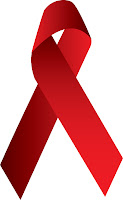Sunday, November 29, 2009
December 1 is WORLD AIDS DAY
World AIDS Day is about raising money, increasing awareness, fighting prejudice and improving education. The World AIDS Day theme for 2009 is 'Universal Access and Human Rights'. World AIDS Day is important in reminding people that HIV has not gone away, and that there are many things still to be done.
According to UNAIDS estimates, there are now 33.4 million people living with HIV, including 2.1 million children. During 2008 some 2.7 million people became newly infected with the virus and an estimated 2 million people died from AIDS.1 Around half of all people who become infected with HIV do so before they are 25 and are killed by AIDS before they are 35.2
The vast majority of people with HIV and AIDS live in lower- and middle-income countries. But HIV today is a threat to men, women and children on all continents around the world.
HIV/AIDS in the Philippines
The Philippines is a low-HIV-prevalence country, with less than 0.1 percent of the adult population estimated to be HIV-positive. Since 1984, when the Philippines’ first case of HIV was reported, approximately one-third of diagnosed HIV/AIDS cases have occurred among returning migrants. However, because HIV testing for these workers is mandatory in most host countries, this number may be disproportionately high. As of September 2007, the Department of Health (DOH) AIDS Registry in the Philippines reported 2,965 people living with HIV/AIDS (PLWHA). UNAIDS estimates that 12,000 Filipinos were HIV-positive by the end of 2005.
Heterosexual intercourse accounts for the majority (61 percent) of the Philippines’ reported HIV/AIDS cases, followed in descending order by homosexual and bisexual relations, mother-to-child transmission, contaminated blood and blood products, and injecting drug use, according to UNAIDS. Men comprise 66 percent of reported cases. Most-at-risk groups include men who have sex with men (MSM), 1 to 3 percent of whom were found to be HIV-positive by sentinel surveillance conducted in Cebu and Quezon cities in 2001, and injecting drug users (IDUs), 1 percent of whom were found to be HIV-positive in Cebu City in 2005. A high rate of needle sharing among IDUs in some areas (77 percent in Cebu City) is of concern. Sex workers, because of their infrequent condom use, high rates of sexually transmitted infections (STIs), and other factors, are also considered to be at risk. In 2002, just 6 percent of sex workers interviewed said they used condoms in the last week. As of 2005, however, HIV prevalence among sex workers in Cebu City was relatively low, at 0.2 percent.
Several factors put the Philippines in danger of a broader HIV/AIDS epidemic. They include increasing population mobility within and outside of the Philippine islands; a conservative culture, adverse to publicly discussing issues of a sexual nature; rising levels of sex work, causal sex, unsafe sex, and injecting drug use; high STI prevalence and poor health-seeking behaviors among at-risk groups; gender inequality; weak integration of HIV/AIDS responses in local government activities; shortcomings in prevention campaigns; inadequate social and behavioral research and monitoring; and the persistence of stigma and discrimination, which results in the relative invisibility of PLWHA. Lack of knowledge about HIV among the Filipino population is troubling. Approximately two-thirds of young women lack comprehensive knowledge on HIV transmission, and 90 percent of the population of reproductive age believe you can contract HIV by sharing a meal with someone.
References:
1. UNAIDS (2009, November), 'AIDS epidemic update'
2. UNAIDS (2008, August), '2008 Report on the Global AIDS Epidemic'.
3. WHO, UNAIDS & UNICEF (2009, September), 'Towards universal access: scaling up priority HIV/AIDS interventions in the health sector'.
4. USAID HIV/AIDS Health Profile for the Philippines - September 2008
Beginnings
Beginnings
It was on July 6, 2009 when 41 individuals gathered at the Humanities Steps and marked the establishment of UPLB Babaylan, a gay, lesbian, bisexual and transgender (LGBT) students' support group which believes in the inherent equality of all persons regardless of status or condition. For the organization, this inherent equality implies that human beings should not be discriminated against on the basis of their sexual orientation.
Goals
-Forge unity among LGBT communities in UPLB
-Provide support services for LGBT students
-Promote awareness of LGBT issues in the university
Projects
-Lesbian and Gay Rights Advocacies
-Gender Sensitivity Workshops
-Conference and Symposia on LGBT issues
-Networking with National and International LGBT Organizations
Campaigns
-Manila Pride March
-World AIDS Campaign
-International Day Against Homophobia
-Transgender Day of Remembrance
-Anti-Discrimination Bill
Educational Discussions
-Gender, Sex and Sexuality
-HIV/AIDS
-Human Rights
-Vagrancy Law
-Anti-Discrimination Bill
-Gay Lingo
Contact Information
email - uplbbabaylan@gmail.com | mobile - +639162764398



May question ako, ano ang say ng UPLB Babaylan sa recent na pag gawa ng bill criminalizing Same-Sex commitment ceremonies?
ReplyDeleteWorld AIDS Day is observed every year on December 1st. The World Health Organization established World AIDS Day in 1988. World AIDS Day provides governments, national AIDS programs, faith organizations, community organizations, and individuals with an opportunity to raise awareness and focus attention on the global AIDS epidemic.
ReplyDelete